如何搭建 Vue3 + Vite + Tailwind + Typescript + Vue Router4 + Pinia 的6个,简单步骤
https://www.youtube.com/watch?v=0jk3aleuwUM
项目地址:https://gitee.com/ChinaGoogles/Vue3ViteTailwindTypescript
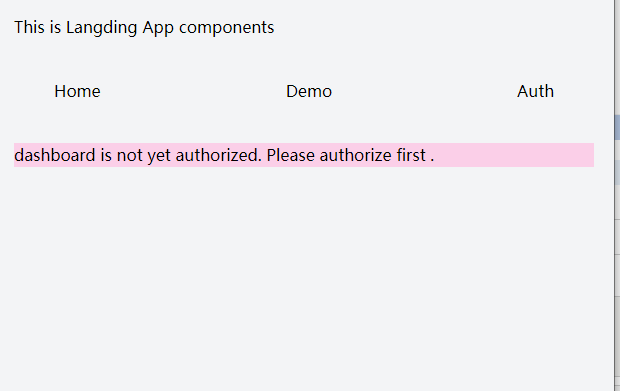
Vite
Vue3
Vue Router4
Typescript
Pinia
Tailwind CSS
Fonts & Icons - (As needed)
第一步
npm create vite@latest
vue3 和 Typescript 在设置vite时候会被选择为选项
1.1 项目名字为viteVueSetup2023

选择Vue
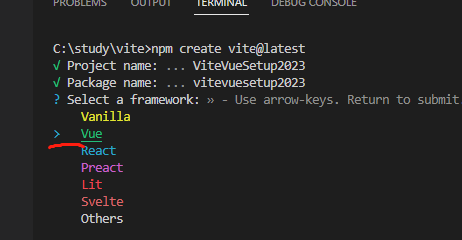
选择TypeScript
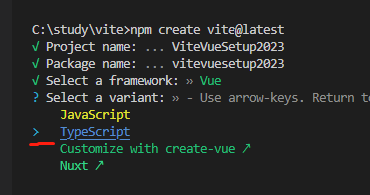
执行这3个
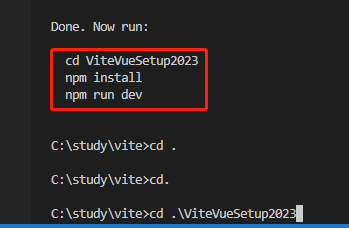
进入ViteVueSetup2023项目之后,我们看看包有什么

二. 安装Vue Router
npm install vue-router@4

三. 安装Pinia
npm install pinia

四. 安装Tailwind CSS
npm install -D tailwindcss postcss autoprefixer
-D:带有此标志的包将作为开发依赖项安装。这意味着,它们只在开发环境中使用,而不会在最终的生产应用程序包中发布
实用工具优先的CSS框架构建自定义Ul
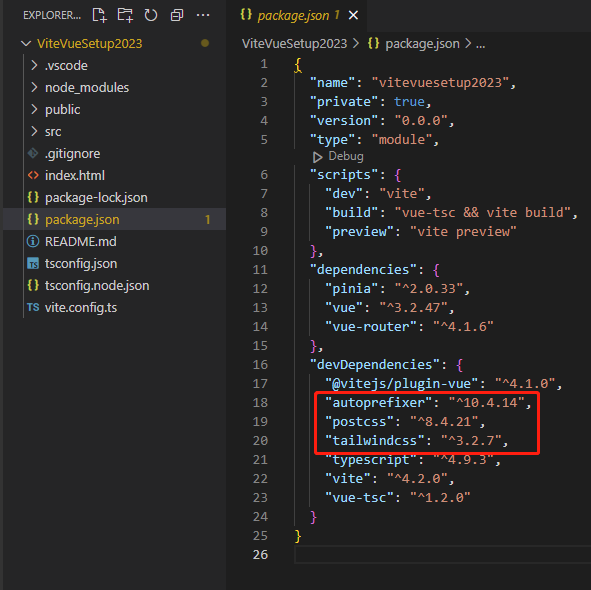
五. 初始化包
- 安装所有节点包
- 初始化Tailwind CSS
- 设置PostCSS模块导出
- 安装TailwindCSS智能感知
- 设置漂亮的插件(如果需要)
- 设置Vite / Typescript别名(方便文件夹路径)(如果需要的话)
1.1 执行
npm install
1.2 再执行,生成一个tailwind.config.cjs文件
npx tailwindcss init

1.3 新建一个postcss.config.cjs文件
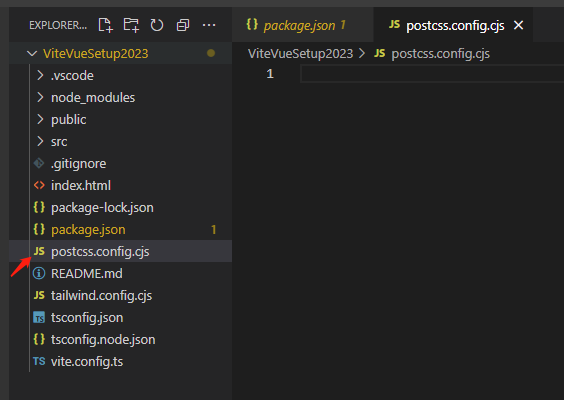
输入
module.exports={
plugins:{
tailwindcss:{},
autoprefixer:{},
}
}
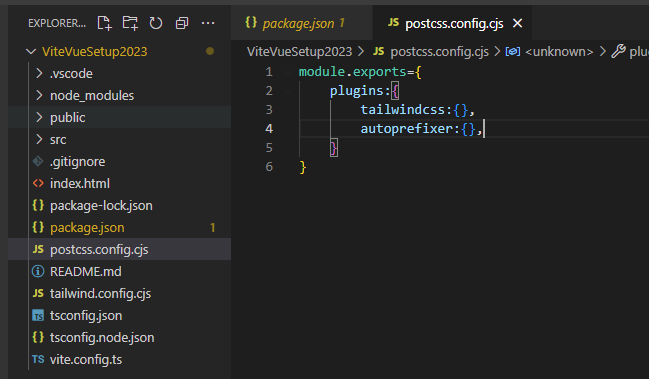
1.4 安装插件 tailwind css

安装插件Prettier - Code formatter

1.5 npm 安装prettier
npm install -D prettier prettier-plugin-tailwindcss

1.6 新建一个.prettierrc.json
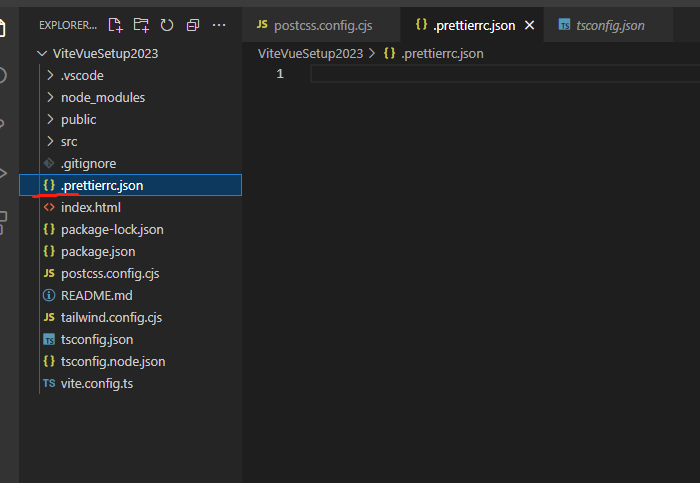
1.7 在tsconfig.json文件中添加baseUrl和paths
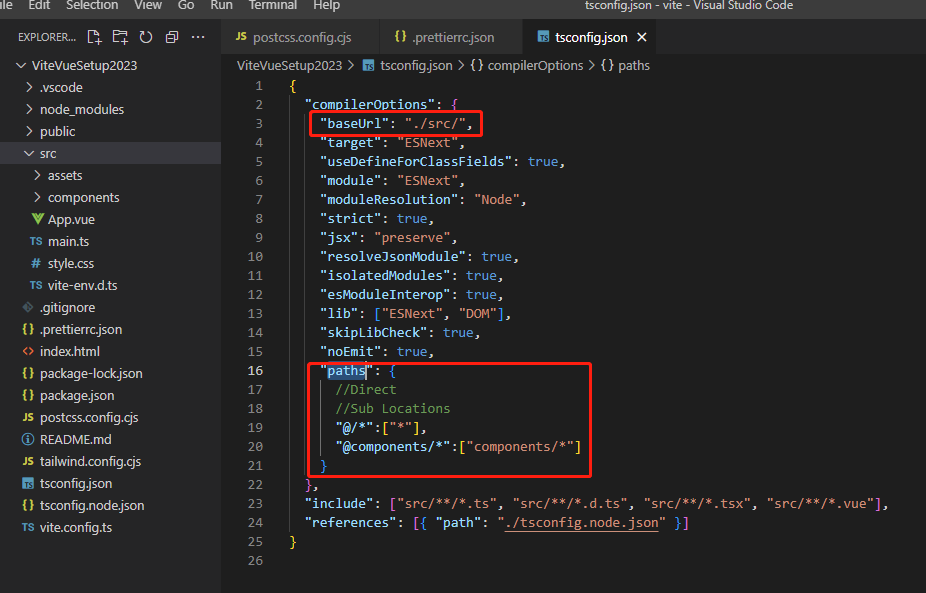
{ "compilerOptions": { "baseUrl": "./src/", "target": "ESNext", "useDefineForClassFields": true, "module": "ESNext", "moduleResolution": "Node", "strict": true, "jsx": "preserve", "resolveJsonModule": true, "isolatedModules": true, "esModuleInterop": true, "lib": ["ESNext", "DOM"], "skipLibCheck": true, "noEmit": true, "paths": { //Direct //Sub Locations "@/*":["*"], "@components/*":["components/*"] } }, "include": ["src/**/*.ts", "src/**/*.d.ts", "src/**/*.tsx", "src/**/*.vue"], "references": [{ "path": "./tsconfig.node.json" }] }
1.8 设置vite.config.ts 文件
先执行
npm install -D @types/node
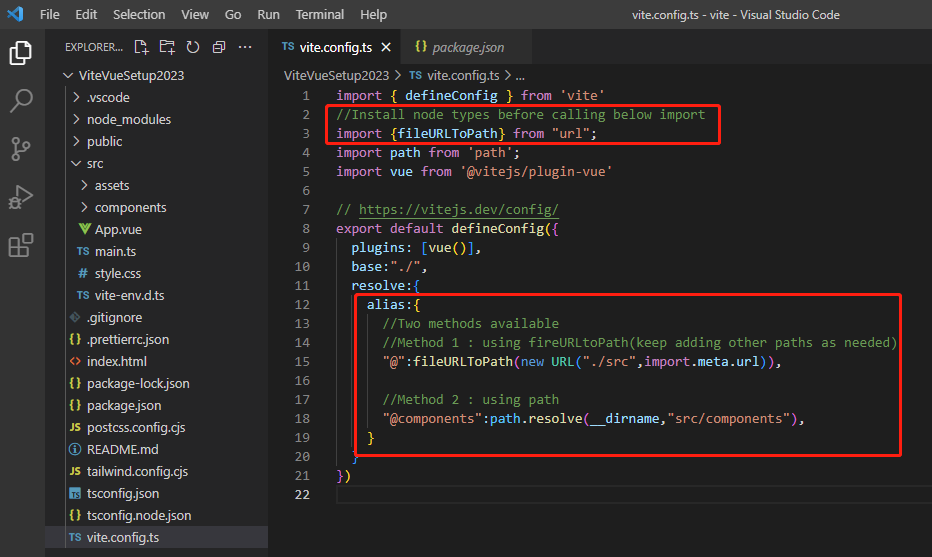
import { defineConfig } from 'vite'
//Install node types before calling below import
import {fileURLToPath} from "url";
import path from 'path';
import vue from '@vitejs/plugin-vue'
// https://vitejs.dev/config/
export default defineConfig({
plugins: [vue()],
base:"./",
resolve:{
alias:{
//Two methods available
//Method 1 : using fireURLtoPath(keep adding other paths as needed)
"@":fileURLToPath(new URL("./src",import.meta.url)),
//Method 2 : using path
"@components":path.resolve(__dirname,"src/components"),
}
}
})
1.9 执行 npm run dev


六 . 配置使用tailwind
1.1 原因
在这一点上,我们只是安装tailwind。
步骤1:必须指示加载文件格式(应该访问顺风的地方)
步骤2:CSS应该包括tailwindimports。
我们运行 npm run dev的时候发生警告
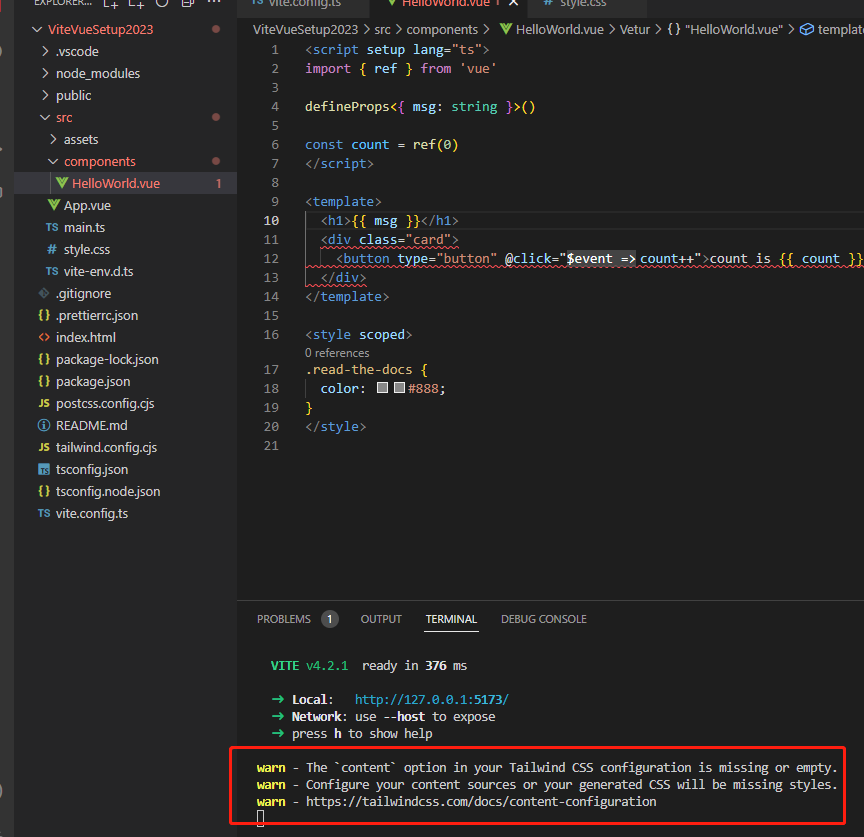
警告 - Tailwind CSS 配置中的“内容”选项缺失或为空。
警告 - 配置内容源,否则生成的 CSS 将缺少样式。
警告 - https://tailwindcss.com/docs/content-configuration
1.2 打开 tailwind.config.cjs文件
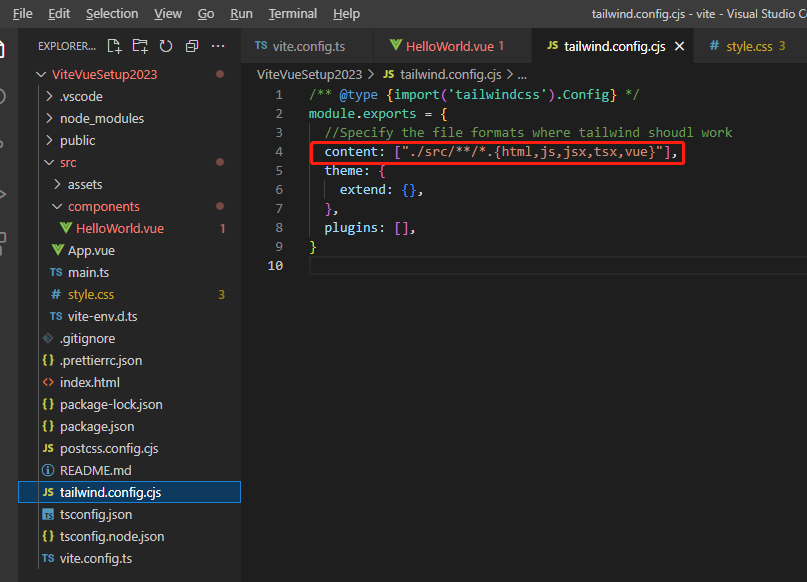
/** @type {import('tailwindcss').Config} */ module.exports = { //Specify the file formats where tailwind shoudl work content: ["./src/**/*.{html,js,jsx,tsx,vue}"], theme: { extend: {}, }, plugins: [], }
打开 style.css

@tailwind base; @tailwind components; @tailwind utilities; :root { font-family: Inter, system-ui, Avenir, Helvetica, Arial, sans-serif; line-height: 1.5; font-weight: 400; }
1.3 在tsconfig中包含vite配置
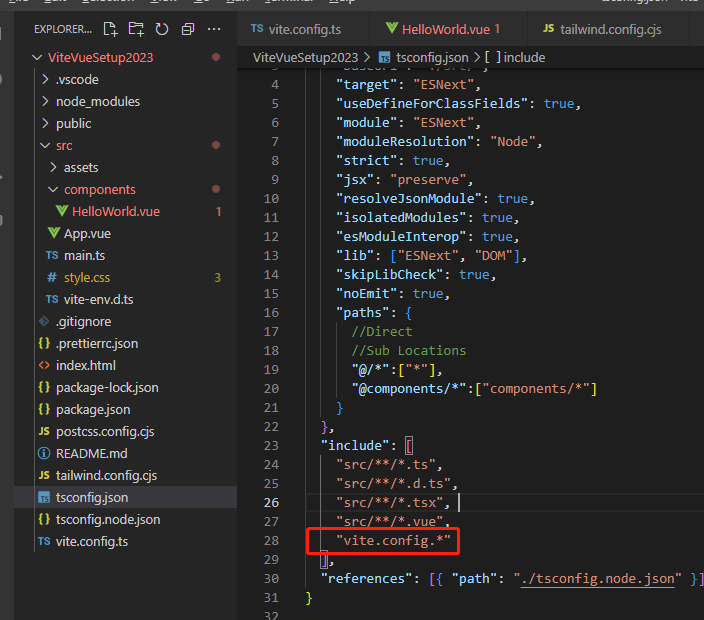
{ "compilerOptions": { "baseUrl": "./src/", "target": "ESNext", "useDefineForClassFields": true, "module": "ESNext", "moduleResolution": "Node", "strict": true, "jsx": "preserve", "resolveJsonModule": true, "isolatedModules": true, "esModuleInterop": true, "lib": ["ESNext", "DOM"], "skipLibCheck": true, "noEmit": true, "paths": { //Direct //Sub Locations "@/*":["*"], "@components/*":["components/*"] } }, "include": [ "src/**/*.ts", "src/**/*.d.ts", "src/**/*.tsx", "src/**/*.vue", "vite.config.*" ], "references": [{ "path": "./tsconfig.node.json" }] }
我们已经准备好开始在vue 3中使用tailwind和typescript
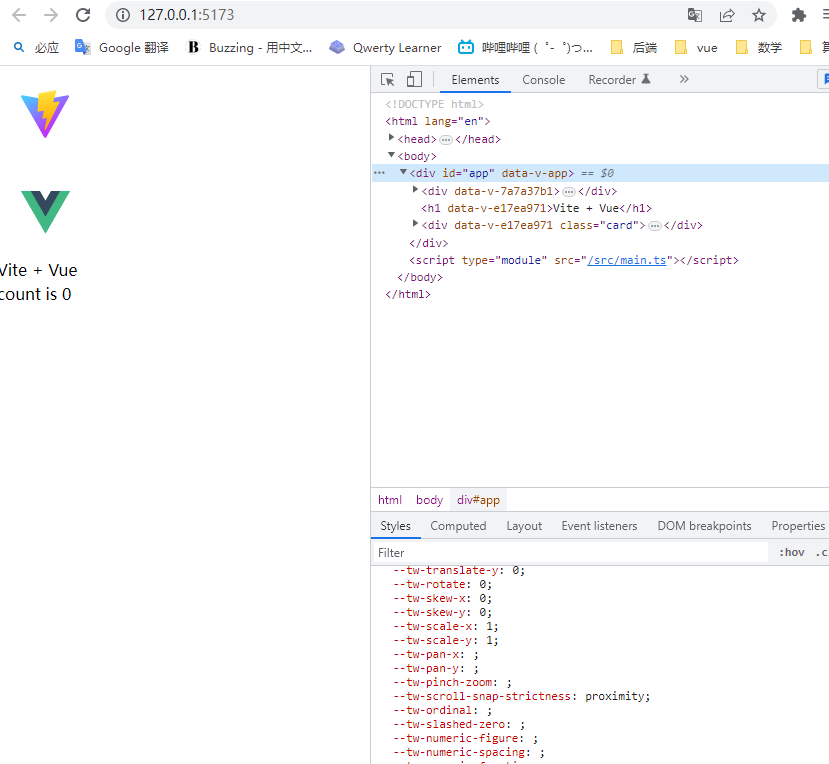
七,使用 tailwind
1.1 添加类
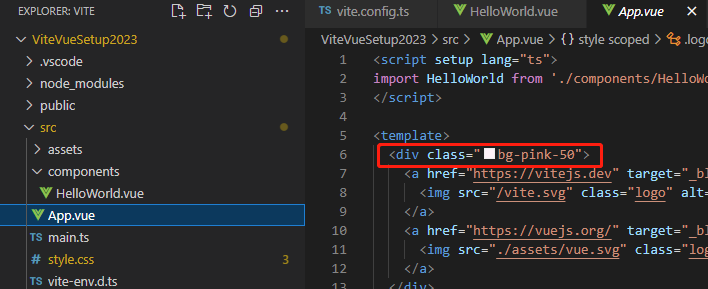

1.2 在style.css文件使用

@tailwind base; @tailwind components; @tailwind utilities; :root { font-family: Inter, system-ui, Avenir, Helvetica, Arial, sans-serif; line-height: 1.5; font-weight: 400; } body{ @apply bg-green-100 p-5 m-0 w-full h-screen; }
import 可以修改

改成
import HelloWorld from '@components/HelloWorld.vue'
WORKS Typescript
WORKS Tailwind ----------------完
TypeScript Vue Plugin (Volar)
Vue VSCode Snippets
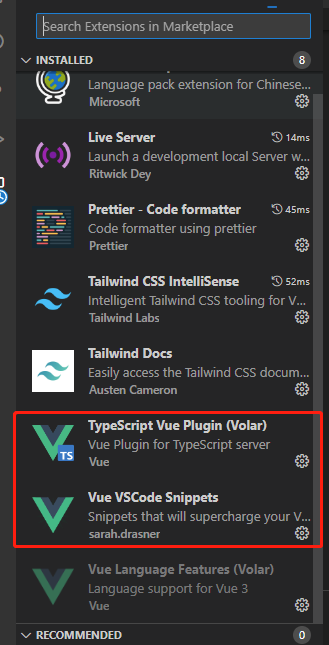
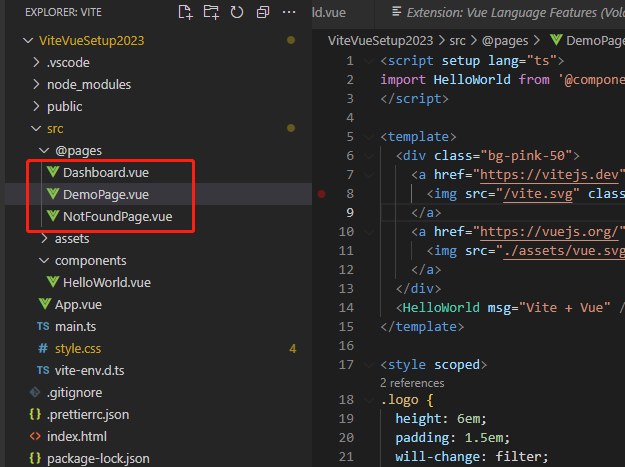
Dashboard.vue
<template>
<div>
This is dashboard
</div>
</template>
<script setup lang="ts">
</script>
<style scoped>
</style>
NotFoundPage.vue
<template>
<div>
Page not found
</div>
</template>
<script setup lang="ts">
</script>
<style scoped>
</style>
DemoPage.vue
<script setup lang="ts"> import HelloWorld from '@components/HelloWorld.vue' </script> <template> <div class="bg-pink-50"> <a href="https://vitejs.dev" target="_blank"> <img src="/vite.svg" class="logo" alt="Vite logo" /> </a> <a href="https://vuejs.org/" target="_blank"> <img src="./assets/vue.svg" class="logo vue" alt="Vue logo" /> </a> </div> <HelloWorld msg="Vite + Vue" /> </template> <style scoped> .logo { height: 6em; padding: 1.5em; will-change: filter; transition: filter 300ms; } .logo:hover { filter: drop-shadow(0 0 2em #646cffaa); } .logo.vue:hover { filter: drop-shadow(0 0 2em #42b883aa); } </style>
App.vue换成
<template> <div> This is Langding App components </div> </template> <script setup lang="ts"> </script> <style scoped> </style>
1.3 在src下面新建一个文件夹 routes, 再建一个router.ts文件

vite.config.ts 文件添加 "@pages":path.resolve(__dirname,"src/@Pages"),
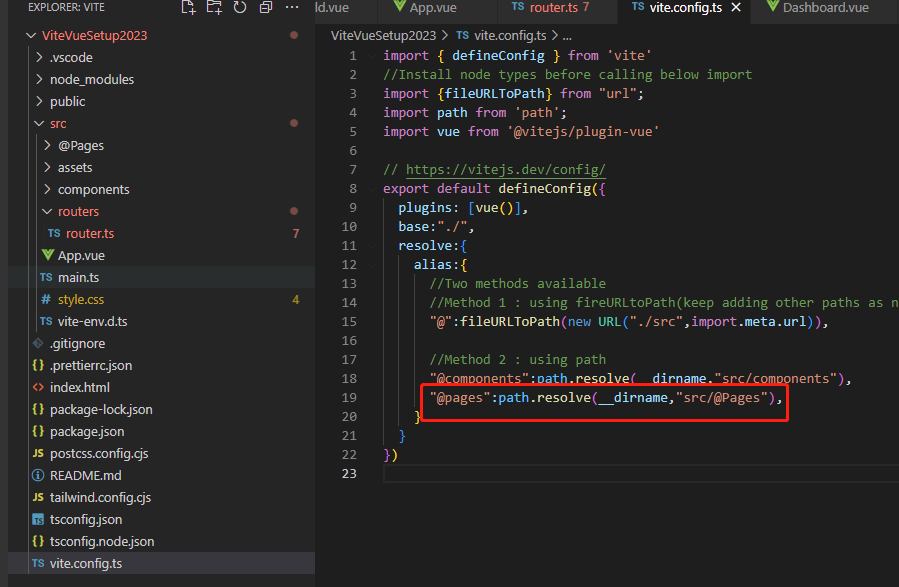
tsconfig.json 添加 "@pages/*":["@Pages/*"],

routers文件夹下的 reouter.ts ,---------------------》history:vR.createMemoryHistory()这个模式最好看文档,注意一下,看不同需求,目前我用的是history:vR.createWebHistory()
import * as vR from 'vue-router'; import DashboardVue from '@pages/Dashboard.vue'; import Pnf from "@pages/NotFoundPage.vue" //Create a router and then export it const _routes:Array<vR.RouteRecordRaw> = [ //Path 6 Component are mandatory { path:"/", component:DashboardVue, name:"home" }, { path:"/demo", component:()=>import("@pages/DemoPage.vue"),//Lazy Loading to defer loading only when required name:"home.demo" //Use defined kepp dot notation to have elegant design }, { path:"/nf", //need to change with regex to catch all non-defined component:Pnf, name:"home.missing" }, ]; const router = vR.createRouter({ history:vR.createMemoryHistory(),//webHash history will add hash before every route routes:_routes, //Send the routes here. }) export default router;
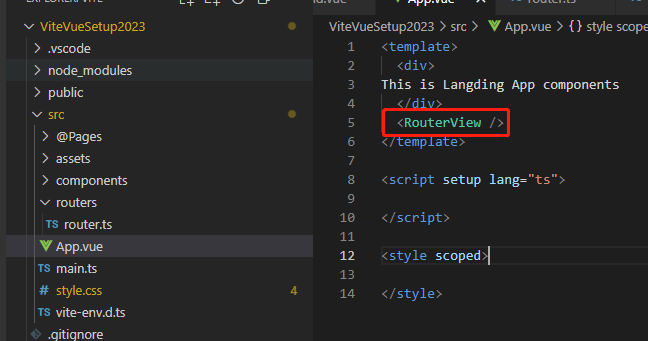
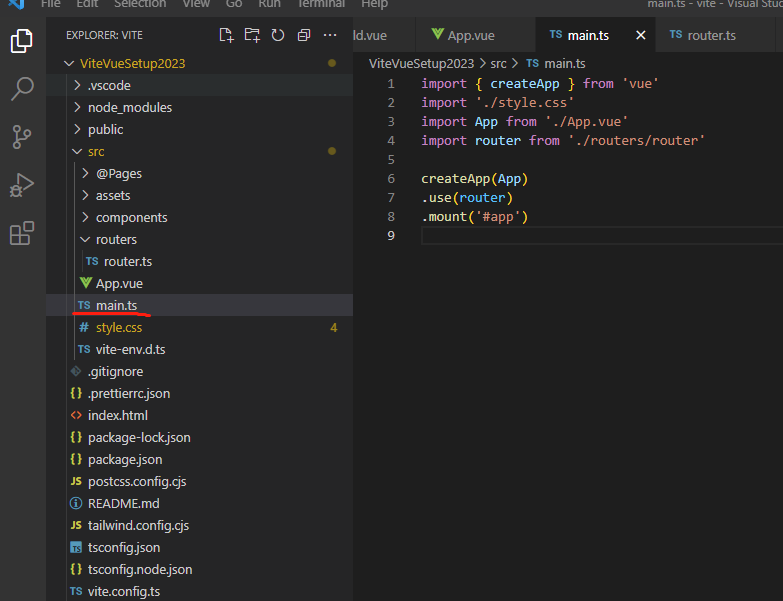
import { createApp } from 'vue'
import './style.css'
import App from './App.vue'
import router from './routers/router'
createApp(App)
.use(router)
.mount('#app')
<template> <div > This is Langding App components <ul> <RouterLink to="/" > <li>Home</li> </RouterLink> <RouterLink to="/demo" > <li>Demo</li> </RouterLink> <RouterLink to="/auth" > <li>Auth</li> </RouterLink> </ul> </div> <RouterView /> </template> <script setup lang="ts"> </script> <style scoped> </style>
在@Pages文件夹添加多一个文件,AuthPage.vue
<template>
<div>
Authorize me
</div>
</template>
<script setup lang="ts">
</script>
<style scoped>
</style>
router.ts文件
{ path:"/auth", component:()=>import("@pages/AuthPage.vue"),//Lazy Loading to defer loading only when required name:"home.auth" //Use defined kepp dot notation to have elegant design },
最后切换
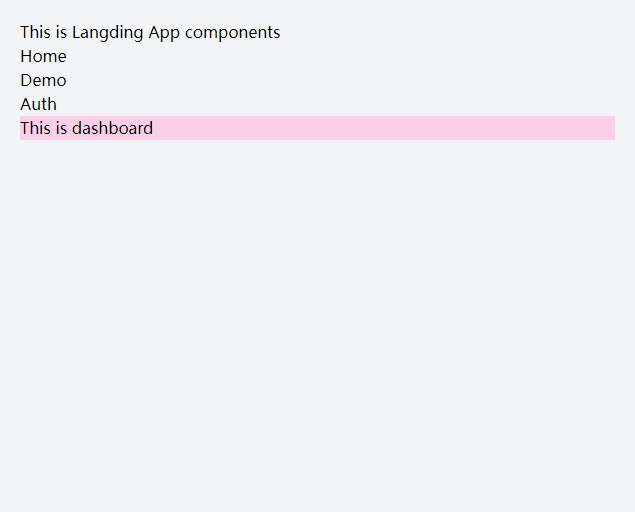
Router ----------WORKS 完
Pinia---- start
使用pinia可以设置多个stores
1.1 src下新建@Store文件夹和authStore.ts文件
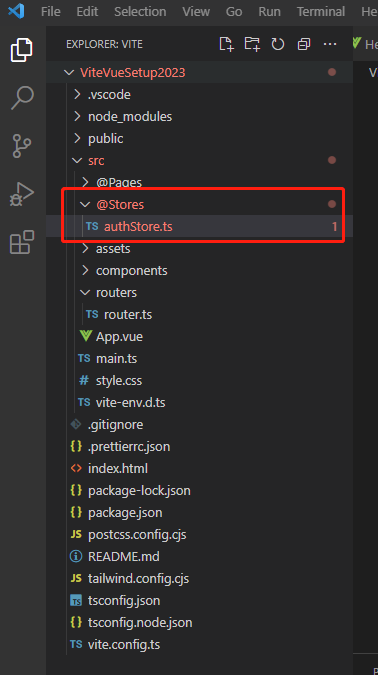
authStore.ts文件内容
import * as pin from 'pinia'; import {ref} from "vue"; const useAuthStore =pin.defineStore('auth',()=>{ const is_authorized = ref<Boolean>(false); const username=ref<string>(); function authenticate(status:boolean,user_name?:string){ is_authorized.value = status; username.value=user_name; console.log(is_authorized,user_name); } return{ //State is_authorized, username, //Actions authenticate, }; }) export default{ useAuthStore }
1.2 执行命令
npm install -D unplugin-auto-import
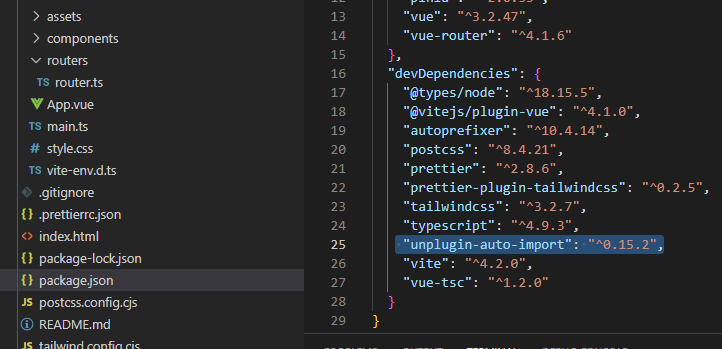
1.3 到vite.config.ts文件,引入使用
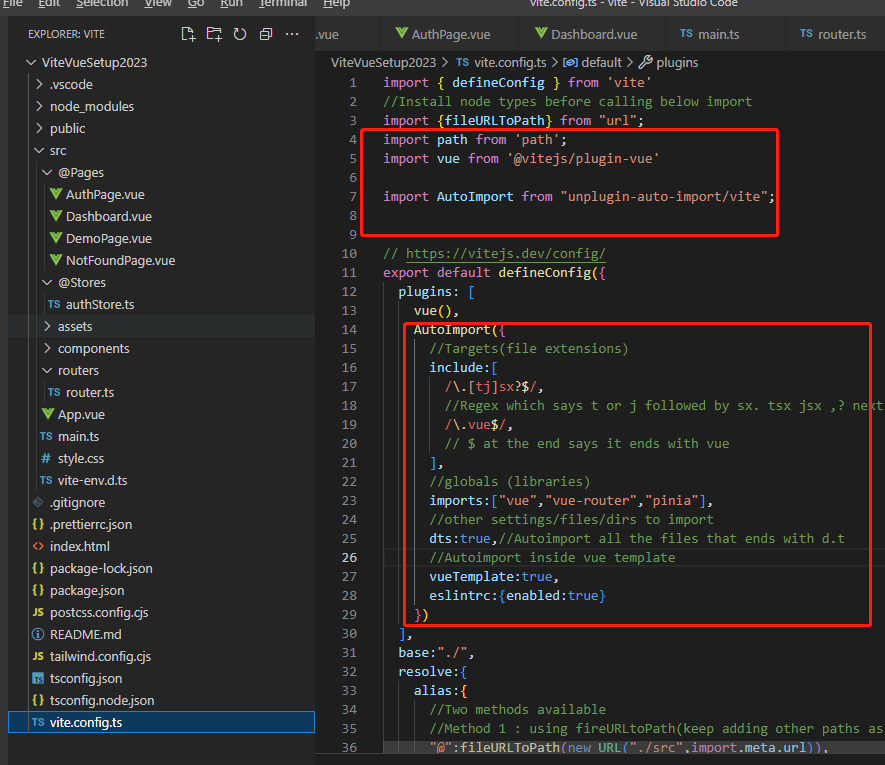
import { defineConfig } from 'vite'
//Install node types before calling below import
import {fileURLToPath} from "url";
import path from 'path';
import vue from '@vitejs/plugin-vue'
import AutoImport from "unplugin-auto-import/vite";
// https://vitejs.dev/config/
export default defineConfig({
plugins: [
vue(),
AutoImport({
//Targets(file extensions)
include:[
/\.[tj]sx?$/,
//Regex which says t or j followed by sx. tsx jsx ,? next to x says it can happen zero or one time js ,ts
/\.vue$/,
// $ at the end says it ends with vue
],
//globals (libraries)
imports:["vue","vue-router","pinia"],
//other settings/files/dirs to import
dts:true,//Autoimport all the files that ends with d.t
//Autoimport inside vue template
vueTemplate:true,
eslintrc:{enabled:true}
})
],
base:"./",
resolve:{
alias:{
//Two methods available
//Method 1 : using fireURLtoPath(keep adding other paths as needed)
"@":fileURLToPath(new URL("./src",import.meta.url)),
//Method 2 : using path
"@components":path.resolve(__dirname,"src/components"),
"@pages":path.resolve(__dirname,"src/@Pages"),
}
}
})
1.4 转到AuthPage.vue页面
<template>
<div class="bg-green-200">
<input @click="authorize" type="button" class="bg-blue-300 p-1 m-1 cursor-pointer hover:bg-blue-500 hover:text-white" value="Authorize me">
<span :class="auth.is_authorized? 'text-green-500':'text-red-500'" class="text-red-500">{{ auth.is_authorized }}</span>
</div>
</template>
<script setup lang="ts">
//we can import ref, router ,route and other itens from vue , vue-router
//pinia each time. Or use auto plugin to do it once.
//Now , we don't need to import ref keyword
import authStore from '@/@Stores/authStore';
const auth =authStore.useAuthStore();
// const isAuthorized = ref<boolean>(false);
//this state remains only in this component.So store it in pini store to share
//with other cpmps
function getRandomString():string{
return (Math.random().toString(36).substring(2,10));
}
function authorize(){
console.log(getRandomString());
let uname = getRandomString();
auth.authenticate(!auth.is_authorized,uname);//either give direct value or invert it .
}
</script>
<style scoped>
</style>
1.5 自动导入文件生成的所有必需的输入。在tsconfig中包含这个auto importfile
打开 tsconfig.json 文件,在“include”,加入“auto-imports.d.ts”
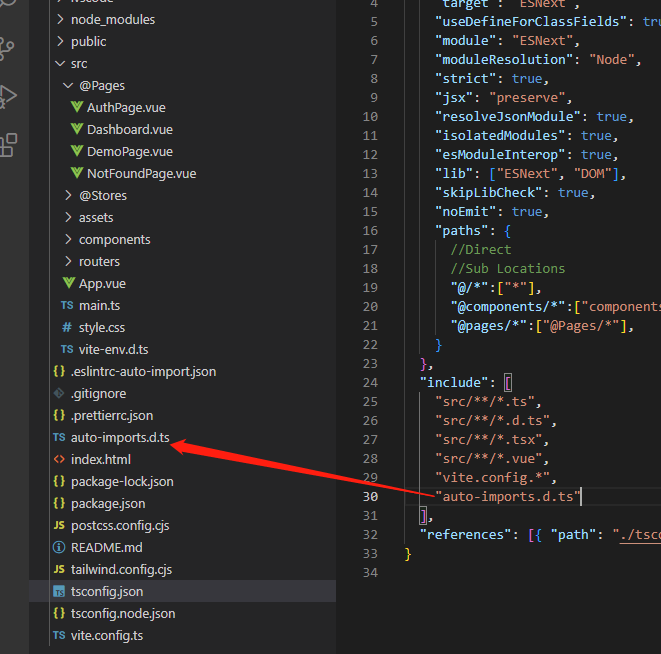
import { createApp } from 'vue'
import { createPinia } from 'pinia'
import './style.css'
import App from './App.vue'
import router from './routers/router'
const _pinia = createPinia();
createApp(App)
.use(_pinia)
.use(router)
.mount('#app')
<template>
<div class="bg-green-200">
<input @click="authorize" type="button" class="bg-blue-300 p-1 m-1 cursor-pointer hover:bg-blue-500 hover:text-white" value="Authorize me">
<span :class="auth.is_authorized? 'text-green-500':'text-red-500'" class="text-red-500">{{ auth.is_authorized }}</span>
</div>
</template>
<script setup lang="ts">
//we can import ref, router ,route and other itens from vue , vue-router
//pinia each time. Or use auto plugin to do it once.
//Now , we don't need to import ref keyword
import authStore from '@/@Stores/authStore';
const auth =authStore.useAuthStore();
// const isAuthorized = ref<boolean>(false);
//this state remains only in this component.So store it in pini store to share
//with other cpmps
function getRandomString():string{
return (Math.random().toString(36).substring(2,10));
}
function authorize(){
console.log(getRandomString());
let uname = getRandomString();
auth.authenticate(!auth.is_authorized,uname);//either give direct value or invert it .
}
</script>
<style scoped>
</style>
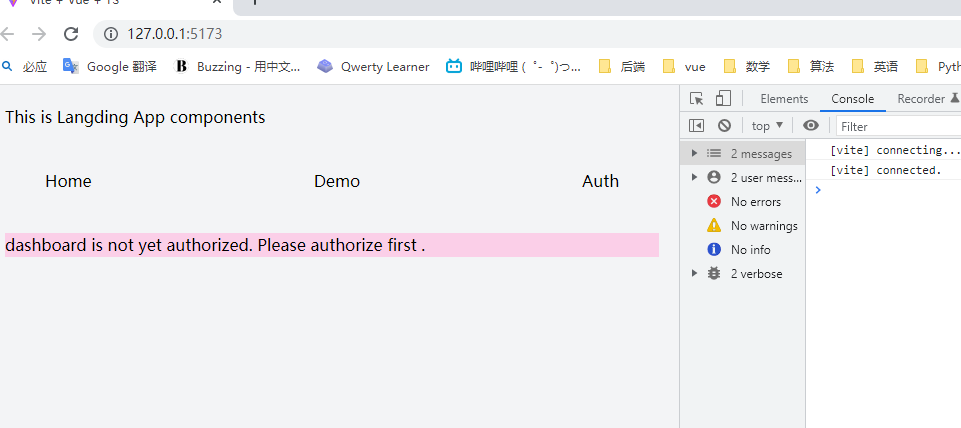
2.
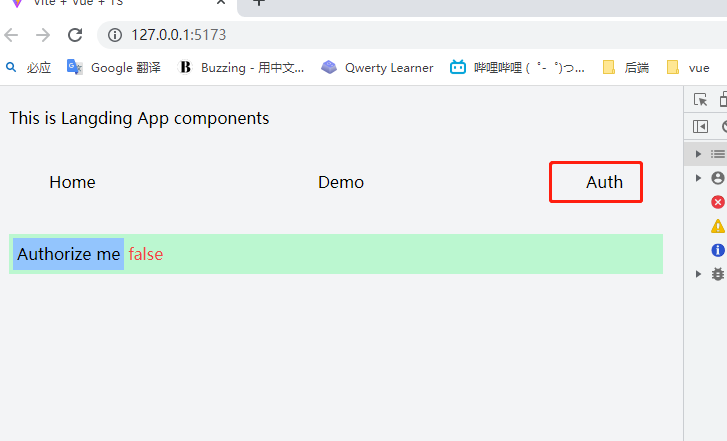
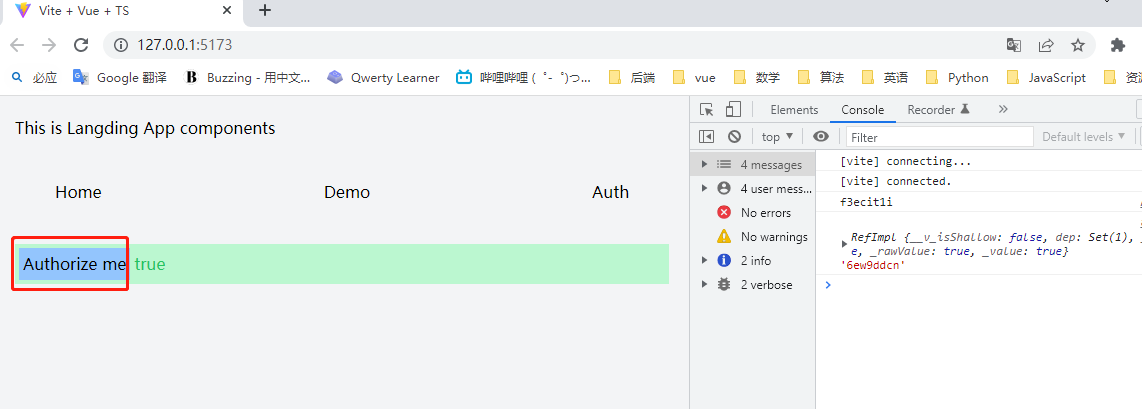
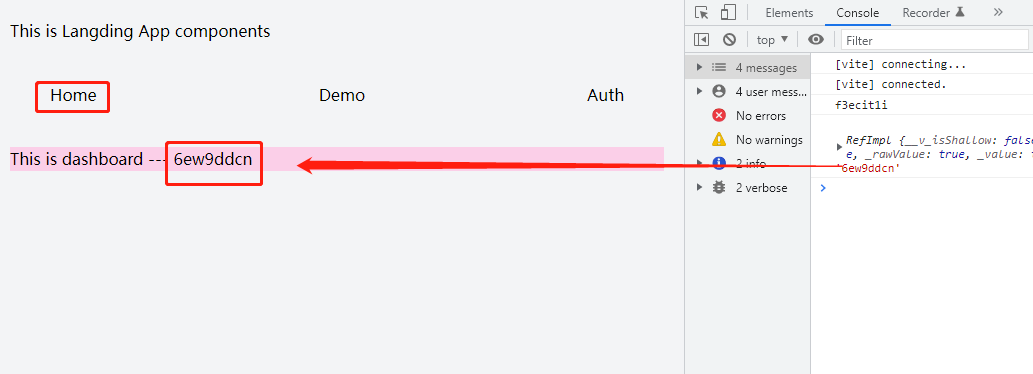






【推荐】国内首个AI IDE,深度理解中文开发场景,立即下载体验Trae
【推荐】编程新体验,更懂你的AI,立即体验豆包MarsCode编程助手
【推荐】抖音旗下AI助手豆包,你的智能百科全书,全免费不限次数
【推荐】轻量又高性能的 SSH 工具 IShell:AI 加持,快人一步
· 分享一个免费、快速、无限量使用的满血 DeepSeek R1 模型,支持深度思考和联网搜索!
· 基于 Docker 搭建 FRP 内网穿透开源项目(很简单哒)
· ollama系列01:轻松3步本地部署deepseek,普通电脑可用
· 25岁的心里话
· 按钮权限的设计及实现